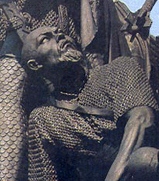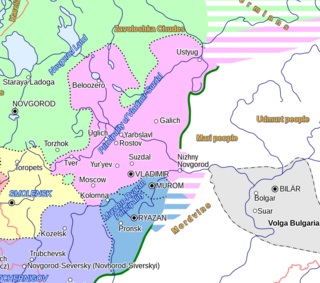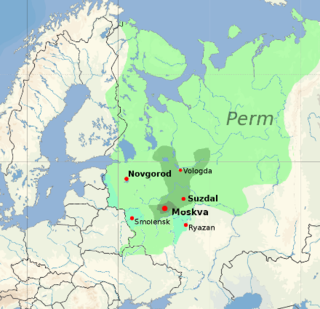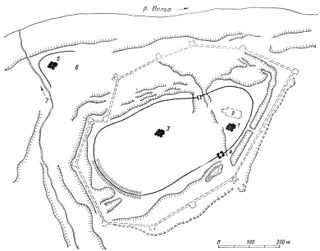
The Golden Horde, self-designated as Ulug Ulus, was originally a Mongol and later Turkicized khanate established in the 13th century and originating as the northwestern sector of the Mongol Empire. With the division of the Mongol Empire after 1259, it became a functionally separate khanate. It is also known as the Kipchak Khanate or as the Ulus of Jochi, and it replaced the earlier, less organized Cuman–Kipchak confederation.

Dmitry Ivanovich Donskoy was Prince of Moscow from 1359 and Grand Prince of Vladimir from 1363 until his death. He was the heir of Ivan II.

Vasily I Dmitriyevich was Grand Prince of Vladimir and Moscow from 1389. He was the heir of Dmitry Donskoy, who reigned from 1359 to 1389.

Mamai was a powerful Mongol military commander of the Golden Horde. Contrary to popular misconception, he was not a khan (king), but was a kingmaker for several khans, and dominated parts or all of the Golden Horde for a period of almost two decades in the 1360s and 1370s. Although he was unable to stabilize central authority during the war of succession known as the Great Troubles, Mamai remained a remarkable and persistent leader for decades, while others came and went in rapid succession. His defeat in the Battle of Kulikovo marked the beginning of the decline of the Horde, as well as his own rapid downfall.

Vladimir-Suzdal, formally known as the Principality of Vladimir-Suzdal or Grand Principality of Vladimir (1157–1331), also as Suzdalia or Vladimir-Suzdalian Rus', was one of the major principalities emerging from Kievan Rus' in the late 12th century, centered in Vladimir-on-Klyazma. With time the principality grew into a grand principality divided into several smaller principalities. After being conquered by the Mongol Empire, the principality became a self-governed state headed by its own nobility. A governorship of the principality, however, was prescribed by a jarlig issued from the Golden Horde to a Rurikid sovereign.

Tokhtamysh was Khan (ruler) of the Golden Horde, who briefly succeeded in consolidating the Blue and White Hordes into a single polity.

The Principality of Ryazan, later known as the Grand Principality of Ryazan, was a principality from 1129 to 1521. Its capital was the city of Ryazan, now known as Old Ryazan, which was destroyed in 1237 during the Mongol invasions. The capital was moved to Pereyaslavl-Ryazansky, later renamed Ryazan.
The Prince of Moscow, later known as the Grand Prince of Moscow, was the title of the ruler of the Principality of Moscow, initially a part of the grand principality of Vladimir-Suzdal. By the late 14th century, the grand principality was inherited by the prince of Moscow; the monarch bore the title of grand prince of Vladimir and Moscow and later the title of grand prince of Vladimir, Moscow and all Russia.

The Principality of Moscow or Grand Duchy of Moscow, also known simply as Muscovy, was a principality of the Late Middle Ages centered on Moscow. It eventually evolved into the Tsardom of Russia in the early modern period. The princes of Moscow were descendants of the first prince Daniel, referred to in modern historiography as the Daniilovichi, a branch of the Rurikids.

The Principality of Nizhny Novgorod-Suzdal, also known as Suzdal-Nizhny Novgorod, was a principality formed in 1341. Its main towns were Nizhny Novgorod, Suzdal, Gorokhovets, Gorodets, and Kurmysh. Nizhny Novgorod was the seat of the principality from 1350. The prince Dmitry of Suzdal obtained the yarlik (patent) for the title of Grand Prince of Vladimir from khan Nawruz Beg in 1360.

The Battle of Kulikovo was fought between the forces of Mamai and Russian forces led by Grand Prince Dmitry of Moscow. The battle took place on 8 September 1380, at Kulikovo Field near the Don River and was won by Dmitry, who became known as Donskoy after the battle.

The Muscovite War of Succession, or Muscovite Civil War, was a war of succession in the Grand Duchy of Moscow (Muscovy) from 1425 to 1453. The two warring parties were Vasily II, the son of the previous Grand Prince of Moscow Vasily I, and on the other hand his uncle, Yury Dmitrievich, the Prince of Zvenigorod, and the sons of Yuri Dmitrievich, Vasily Kosoy and Dmitry Shemyaka. In the intermediate stage, the party of Yury conquered Moscow, but in the end, Vasily II regained his crown.

Sary-Aka's embassy was a mission from the commander of the Blue Horde Mamai sent to the Russian eastern border province of Nizhny Novgorod in 1374 to undermine the influence of the Prince of Moscow in his struggle for supremacy among the Russian provinces due to his open opposition to Mongol authority in Russia. The embassy was ambushed and the survivors were imprisoned in the wooden fort of Nizhny Novgorod until 31 March 1375, when Sary-Aka along with the rest of the Tatars were massacred by the Russians.

Vasily Demitryvich Kirdyapa was the eldest son of Dmitri Konstantinovich of Suzdal and Nizhny Novgorod, a Prince of Suzdal (1364–1382) and Gorodets (1387–1403). He was the ancestor of the senior branch of a Rurikid noble family, and the Princes Shuysky.
The Prince of Vladimir, from 1186 Grand Prince of Vladimir, also translated as Grand Duke of Vladimir, was the title of the monarch of Vladimir-Suzdal. The title was passed to the prince of Moscow in 1389.

The Principality of Tver was a principality which existed between the 13th and the 15th centuries with its capital in Tver. It was one of the states established after the decay of the Kievan Rus'. During the 14th century, Tver rivaled the Principality of Moscow with the aim to become the center of the united Russian state. Eventually it lost, decayed, and in 1485, it was annexed by Moscow. The principality was located approximately in the area currently occupied by Tver Oblast and the eastern part of Smolensk Oblast in Russia.

The Tver Uprising of 1327 was the first major uprising against the Golden Horde by the people of Vladimir. It was brutally suppressed by the joint efforts of the Golden Horde, Muscovy and Suzdal. At the time, Muscovy and Vladimir were involved in a rivalry for dominance, and Vladimir's total defeat effectively ended the quarter-century struggle for power. The Golden Horde later became an enemy of Muscovy, and Russia did not become free of Mongol influence until the Great stand on the Ugra river in 1480, more than a century later.
The Battle of the Kalka River in 1381 was fought between the Mongol warlords Mamai and Tokhtamysh for control of the Golden Horde. Tokhtamysh was the victor and became sole ruler of the Horde.

The Great Troubles, also known as the Golden Horde Dynastic War, was a war of succession in the Golden Horde from 1359 to 1381.















